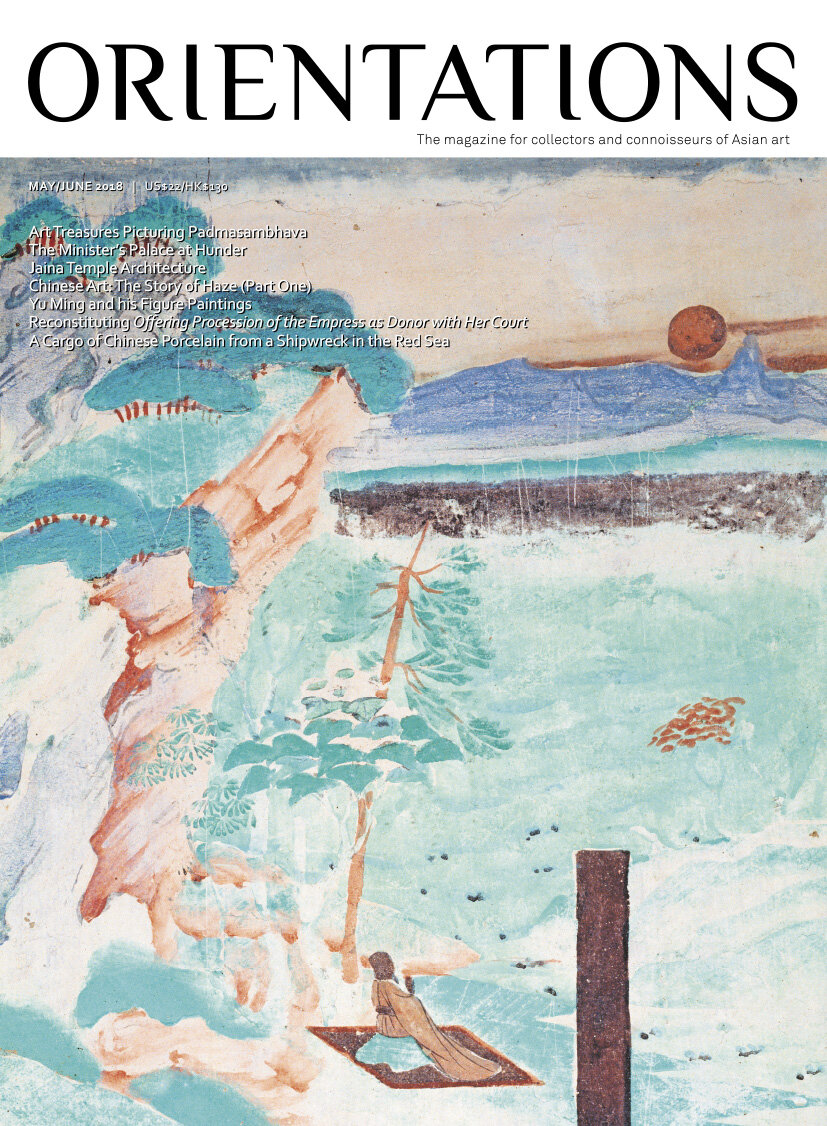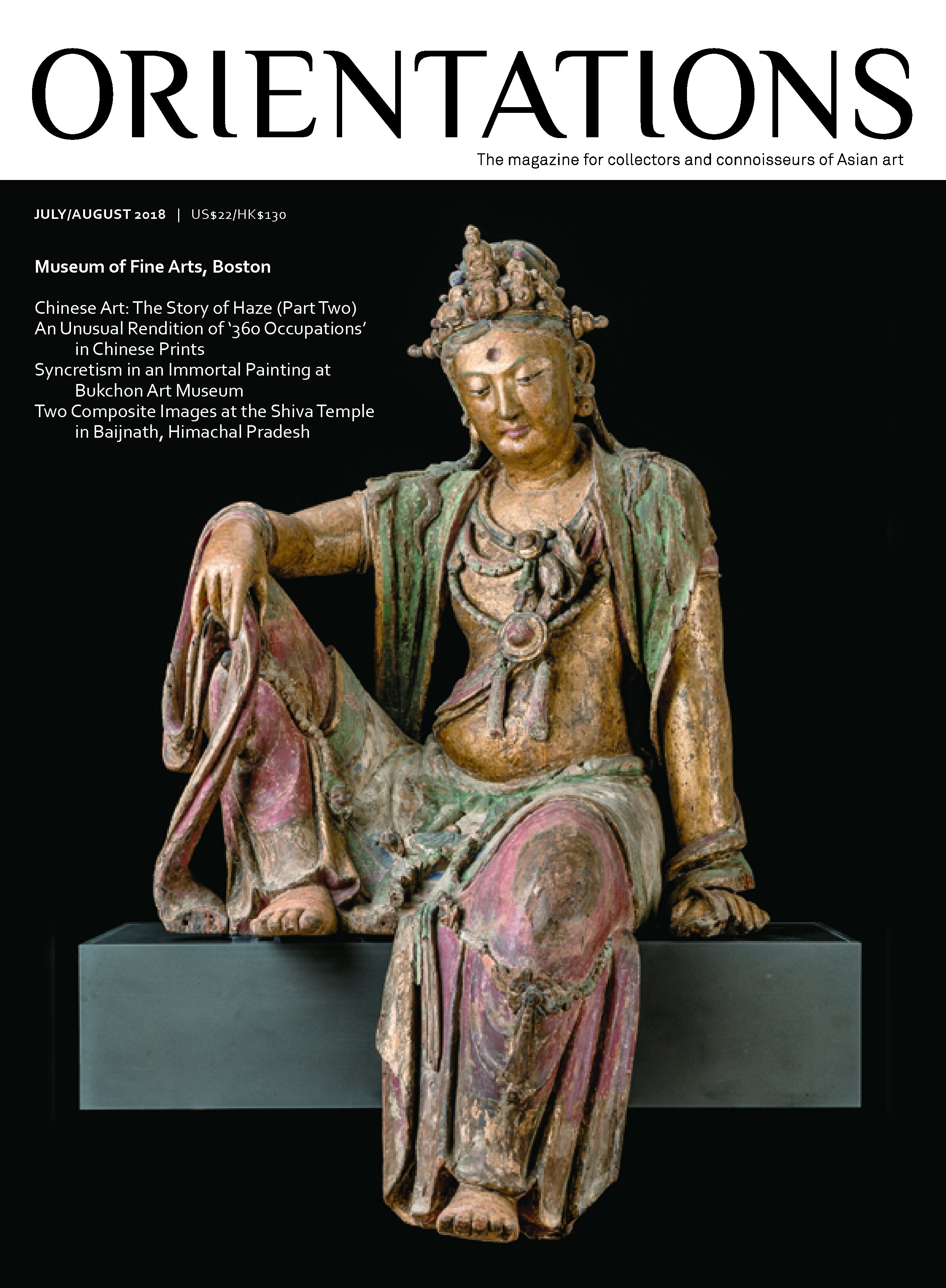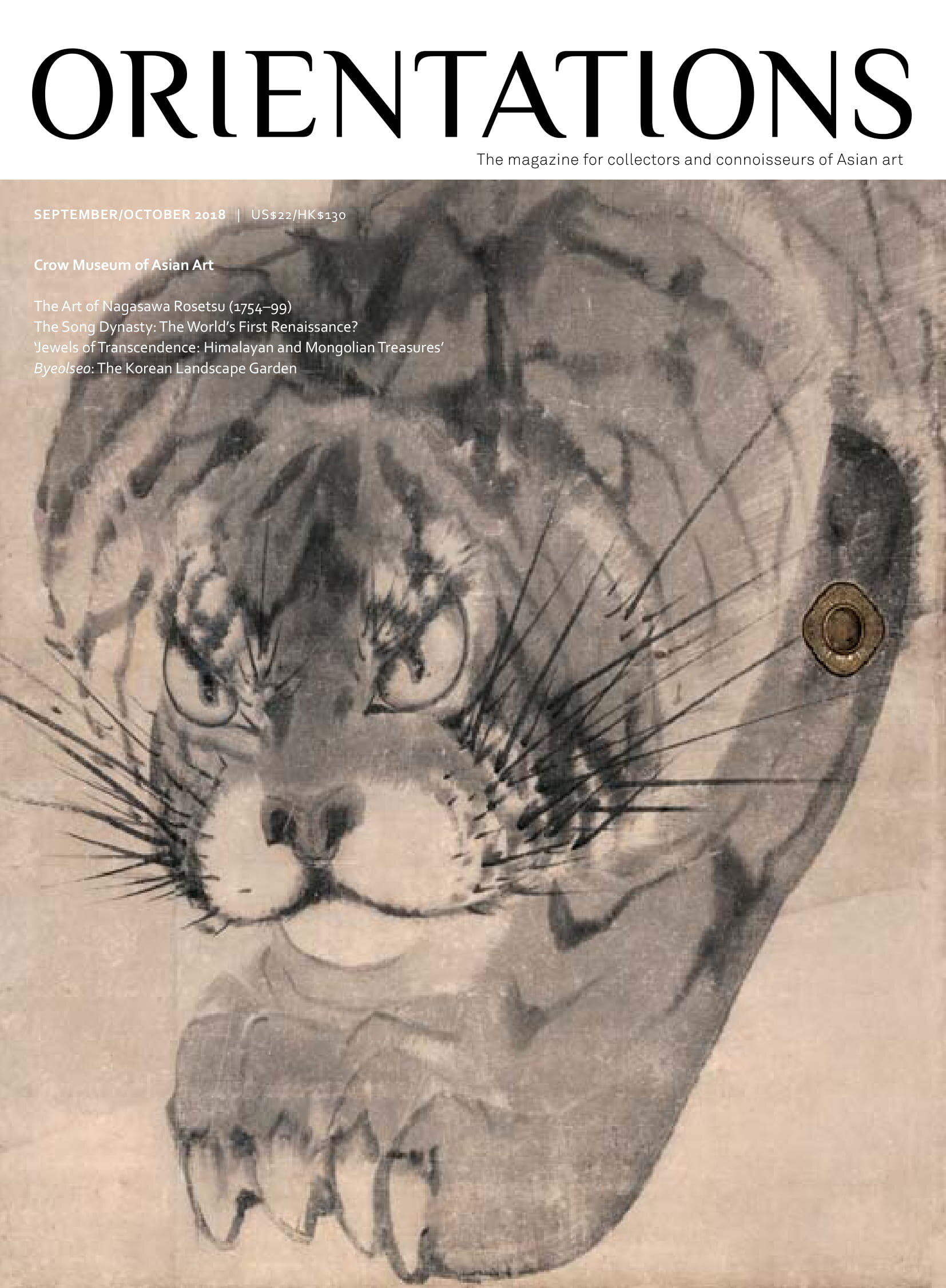MAY/JUN 2018
VOLUME 49 - NUMBER 3
A popular subject in the visual culture of the Tibetan-speaking Himalayan regions and the Tibetan plateau is the tantric adept Padmasambhava, who appears in various iconographic forms. Currently celebrated in an exhibition at The Rubin Museum of Art, the master that introduced Buddhism to 8th century Tibet is the focus of our first article, by curator Elena Pakhoutova. We then move on to Ladakh, with Gerald Kozicz and Diana Lange’s discussion of the Minister’s Palace, or Zimskhang, at Hunder. Situated at the junction of a cross-Himalayan road network, the palace displays an eclectic variety of artwork, shedding new light on the region’s history. Also on the theme of architecture is Julia A. B. Hegewald’s introduction to Jaina temples and the aspects that make them distinct.
The next two articles relate to Chinese painting. Eugene Y. Wang narrates the development of ‘haze’ and how it blazed new paths in Chinese art, while On-tsun Andrew Fung explores the figure paintings of Yu Ming and his engagement with both tradition and modernity.
The relief Offering Procession of the Empress as Donor with Her Court, originally from the Binyang Central Cave at Longmen in China and now in the US, has long been regarded as a canonical example of Chinese figural sculpture. In his article, Fletcher Coleman presents new material documenting the relief’s removal and restoration. Meanwhile, Chiara Visconti offers a fresh view on the origin of the Chinese porcelain cargo discovered in the Umm Lajj shipwreck.
FEATURES
Elena Pakhoutova . Art Treasures Picturing Padmasambhava
Gerald Kozicz and Diana Lange . The Minister’s Palace at Hunder: Reflections on Material and Visual Culture
Julia A. B. Hegewald. Distinctiveness and Diversity in Jaina Temple Architecture
Eugene Y. Wang . Chinese Art: The Story of Haze (Part One)
On-tsun Andrew Fung . Steering between Tradition and Modernity: Yu Ming and his Figure Paintings
Fletcher Coleman . Fragments and Traces: Reconstituting Offering Procession of the Empress as Donor with Her Court
Chiara Visconti . A Cargo of Chinese Porcelain from a Shipwreck in the Red Sea
Stephen Little. From Angkor Wat to Dragon Tiger Mountain
Takahiro Naka . Variety and Concept in Japanese Garden Design
PREVIEWS & REVIEWS
Karina H. Corrigan. Book Reviews Silk, Porcelain and Lacquer: China and Japan and their Trade with Western Europe and the New World, 1500–1644 By Teresa Canepa
Florian Knothe. Book Review: Bolihua: chinesische Hinterglasmalerei aus der Sammlung Mei-Lin By Rupprecht Mayer (Christian Juranek and Christof Trepesch, eds)
Aida Yuen Wong. Exhibition Review ‘Boundless Peaks: Ink Paintings by Minol Araki (1928–2010)’ at Minneapolis Institute of Art, 7 October 2017–24 June 2018
INTERVIEWS
Emerging Voices – Phillip E. Bloom
NEWS
Announcements
International Antiques Fair, Hong Kong
Gallery News
COMMENTARY
Yeonsoo Chee. Commentary: A New Approach to the Repatriation of Cultural Property: Collaborative Investigations
VOLUME 49 - NUMBER 3
A popular subject in the visual culture of the Tibetan-speaking Himalayan regions and the Tibetan plateau is the tantric adept Padmasambhava, who appears in various iconographic forms. Currently celebrated in an exhibition at The Rubin Museum of Art, the master that introduced Buddhism to 8th century Tibet is the focus of our first article, by curator Elena Pakhoutova. We then move on to Ladakh, with Gerald Kozicz and Diana Lange’s discussion of the Minister’s Palace, or Zimskhang, at Hunder. Situated at the junction of a cross-Himalayan road network, the palace displays an eclectic variety of artwork, shedding new light on the region’s history. Also on the theme of architecture is Julia A. B. Hegewald’s introduction to Jaina temples and the aspects that make them distinct.
The next two articles relate to Chinese painting. Eugene Y. Wang narrates the development of ‘haze’ and how it blazed new paths in Chinese art, while On-tsun Andrew Fung explores the figure paintings of Yu Ming and his engagement with both tradition and modernity.
The relief Offering Procession of the Empress as Donor with Her Court, originally from the Binyang Central Cave at Longmen in China and now in the US, has long been regarded as a canonical example of Chinese figural sculpture. In his article, Fletcher Coleman presents new material documenting the relief’s removal and restoration. Meanwhile, Chiara Visconti offers a fresh view on the origin of the Chinese porcelain cargo discovered in the Umm Lajj shipwreck.
FEATURES
Elena Pakhoutova . Art Treasures Picturing Padmasambhava
Gerald Kozicz and Diana Lange . The Minister’s Palace at Hunder: Reflections on Material and Visual Culture
Julia A. B. Hegewald. Distinctiveness and Diversity in Jaina Temple Architecture
Eugene Y. Wang . Chinese Art: The Story of Haze (Part One)
On-tsun Andrew Fung . Steering between Tradition and Modernity: Yu Ming and his Figure Paintings
Fletcher Coleman . Fragments and Traces: Reconstituting Offering Procession of the Empress as Donor with Her Court
Chiara Visconti . A Cargo of Chinese Porcelain from a Shipwreck in the Red Sea
Stephen Little. From Angkor Wat to Dragon Tiger Mountain
Takahiro Naka . Variety and Concept in Japanese Garden Design
PREVIEWS & REVIEWS
Karina H. Corrigan. Book Reviews Silk, Porcelain and Lacquer: China and Japan and their Trade with Western Europe and the New World, 1500–1644 By Teresa Canepa
Florian Knothe. Book Review: Bolihua: chinesische Hinterglasmalerei aus der Sammlung Mei-Lin By Rupprecht Mayer (Christian Juranek and Christof Trepesch, eds)
Aida Yuen Wong. Exhibition Review ‘Boundless Peaks: Ink Paintings by Minol Araki (1928–2010)’ at Minneapolis Institute of Art, 7 October 2017–24 June 2018
INTERVIEWS
Emerging Voices – Phillip E. Bloom
NEWS
Announcements
International Antiques Fair, Hong Kong
Gallery News
COMMENTARY
Yeonsoo Chee. Commentary: A New Approach to the Repatriation of Cultural Property: Collaborative Investigations
VOLUME 49 - NUMBER 3
A popular subject in the visual culture of the Tibetan-speaking Himalayan regions and the Tibetan plateau is the tantric adept Padmasambhava, who appears in various iconographic forms. Currently celebrated in an exhibition at The Rubin Museum of Art, the master that introduced Buddhism to 8th century Tibet is the focus of our first article, by curator Elena Pakhoutova. We then move on to Ladakh, with Gerald Kozicz and Diana Lange’s discussion of the Minister’s Palace, or Zimskhang, at Hunder. Situated at the junction of a cross-Himalayan road network, the palace displays an eclectic variety of artwork, shedding new light on the region’s history. Also on the theme of architecture is Julia A. B. Hegewald’s introduction to Jaina temples and the aspects that make them distinct.
The next two articles relate to Chinese painting. Eugene Y. Wang narrates the development of ‘haze’ and how it blazed new paths in Chinese art, while On-tsun Andrew Fung explores the figure paintings of Yu Ming and his engagement with both tradition and modernity.
The relief Offering Procession of the Empress as Donor with Her Court, originally from the Binyang Central Cave at Longmen in China and now in the US, has long been regarded as a canonical example of Chinese figural sculpture. In his article, Fletcher Coleman presents new material documenting the relief’s removal and restoration. Meanwhile, Chiara Visconti offers a fresh view on the origin of the Chinese porcelain cargo discovered in the Umm Lajj shipwreck.
FEATURES
Elena Pakhoutova . Art Treasures Picturing Padmasambhava
Gerald Kozicz and Diana Lange . The Minister’s Palace at Hunder: Reflections on Material and Visual Culture
Julia A. B. Hegewald. Distinctiveness and Diversity in Jaina Temple Architecture
Eugene Y. Wang . Chinese Art: The Story of Haze (Part One)
On-tsun Andrew Fung . Steering between Tradition and Modernity: Yu Ming and his Figure Paintings
Fletcher Coleman . Fragments and Traces: Reconstituting Offering Procession of the Empress as Donor with Her Court
Chiara Visconti . A Cargo of Chinese Porcelain from a Shipwreck in the Red Sea
Stephen Little. From Angkor Wat to Dragon Tiger Mountain
Takahiro Naka . Variety and Concept in Japanese Garden Design
PREVIEWS & REVIEWS
Karina H. Corrigan. Book Reviews Silk, Porcelain and Lacquer: China and Japan and their Trade with Western Europe and the New World, 1500–1644 By Teresa Canepa
Florian Knothe. Book Review: Bolihua: chinesische Hinterglasmalerei aus der Sammlung Mei-Lin By Rupprecht Mayer (Christian Juranek and Christof Trepesch, eds)
Aida Yuen Wong. Exhibition Review ‘Boundless Peaks: Ink Paintings by Minol Araki (1928–2010)’ at Minneapolis Institute of Art, 7 October 2017–24 June 2018
INTERVIEWS
Emerging Voices – Phillip E. Bloom
NEWS
Announcements
International Antiques Fair, Hong Kong
Gallery News
COMMENTARY
Yeonsoo Chee. Commentary: A New Approach to the Repatriation of Cultural Property: Collaborative Investigations






